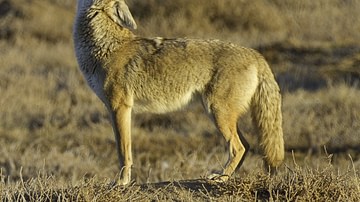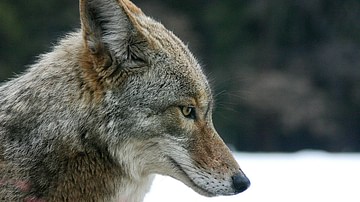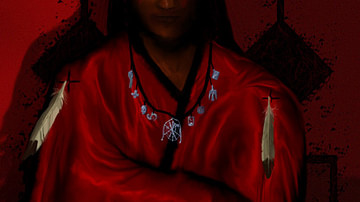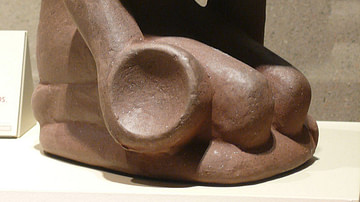The Coyote tales come from the Shasta people who originally inhabited the regions of modern-day northern California and southern Oregon. Coyote is a popular trickster figure among many Native peoples of North America, including the Shasta, and their Coyote tales are among the most popular. Two of the best-known are Why Mount Shasta Erupted and Land of the Ghost Dance.

The Shasta came into contact with Euro-Americans in 1826, and soon after, their traditional lifestyle and culture suffered enormously. Scholar Adele Nozedar comments on their ancestral lands and culture and the challenges they faced after 1826:
Originally, the Shasta lived in California, and are remembered in the names of the Shasta River and Mount Shasta. The tribe lived in permanent villages rather than being nomadic or semi-nomadic, living in plank houses, using dugout canoes, and having acorns as a staple food. The Shasta divided up their territory into areas in which certain families had the right to hunt, a privilege that was handed down the father's line…A peaceful people, the Shasta suffered when the California Gold Rush started in the 1820's, some of them poisoned, for no reason, by settlers…[Later], in common with others, in an attempt to reclaim a sense of identity, the Shasta embraced the Ghost Dance Movement.
(433)
Like the Pawnee, the rituals of the Ghost Dance (which naturally included songs, chants, and prayers in one's native language) helped the Shasta preserve their culture, their language, and the stories handed down through oral transmission for centuries; the Coyote tales among them. In June 2024, Governor Gavin Newsom of California gave back 2,800 acres of ancestral homeland to the Shasta in an initiative to right past injustices. Today, the Shasta continue to rebuild their language and culture and a significant aspect of that effort is their stories.
Coyote Tales of the Shasta
The Coyote tales, like the Iktomi tales of the Lakota Sioux or the Wihio tales of the Cheyenne, feature a central trickster character – who may appear in many different forms and roles but always teaches a lesson and is involved in some sort of transformative event – and, in this case, that main character is Coyote. Scholar Bobby Lake-Thom comments:
Coyote is one of the most ancient mythic symbols for most Native tribes. He is often portrayed as either the creator or the trickster. He is full of magic, special powers, and teachings. We learn from the lessons that Coyote gives us about the mistakes and/or accomplishments he has made in life.
(84)
As with other tricksters, the Coyote of the Shasta people may appear as a hero, a villain, a fool, a wise man, a Creator God, or a con artist depending on the tale. In Why Mount Shasta Erupted and Land of the Ghost Dance, he plays the role of the novice who fails to grasp a given situation; not necessarily a fool, but one lacking in experience and so prone to mistakes. In this role, Coyote is made accessible to an audience who may identify, and sympathize, with his errors and are given the opportunity to learn from them.
Why Mount Shasta Erupted is an origin tale explaining why Mount Shasta of the Cascade Range of modern-day Siskiyou County, California, looks the way it does. The story may also reference the historical event of the volcanic eruption of Mount Shasta c. 1250 and provide an explanation for that. The Shasta – along with other nations including the Klamath and Modoc – inhabited the region around Mount Shasta for approximately 14,000 years before the arrival of Euro-Americans, and the Shasta tale of the c. 1250 eruption could well date to shortly after that event. As the tale was passed down through oral transmission, however, its date of composition is unknown.
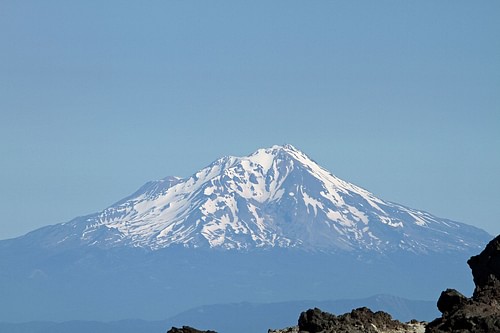
Land of the Ghost Dance shares similarities with death-origin myths of other Native American nations, including How Death Came into the World (Modoc legend) and the Kiowa death-origin myth: two versions - How Death Came into the World and Why the Ant is Almost Cut in Two. In the Shasta story, Coyote decrees death as a necessity but regrets this when his son dies. Land of the Ghost Dance references the vision of the Ghost Dance Movement of 1889 – that the souls of the dead lived on in another, better realm – but stands as a cautionary tale on the dangers of refusing to accept loss and clinging to the past. This theme is common to ghost stories of many different nations, notably The Ghost Wife of the Pawnee.
Text
The following tales are taken from Voices of the Winds: Native American Legends, by Margot Edmonds and Ella Clark, Chartwell Books, 2021.
Why Mount Shasta Erupted
Coyote, a universal and mischievous spirit, lived near Mount Shasta in what is now California. Coyote's village had little fish and no salmon. His neighboring village of Shasta Indians always had more than they could use.
Shasta Indians had built a dam that served as a trap for fish, especially the wonderful salmon. They ate it raw, baked it over hot coals, and dried large quantities for their winter food supply. Other tribes came to Shasta Village to trade for salmon, which created wealth and respect for the Shasta tribe.
One day Coyote was dreaming of a delicious meal of salmon. His mouth watered at the thought of a nice freshly cooked, juicy salmon.
"I am so terribly hungry," he said to himself upon waking. "If I visit the Shasteans, maybe I can have a salmon dinner."
Coyote washed and brushed himself to look neat and clean, then started for Shasta Village with visions of fresh salmon swimming behind his eyes. He found the Shasteans at the dam hauling in big catches of salmon. They welcomed him and said that he could have all the fish he could catch and carry.
Hunger and greed caused Coyote to take more fish than was good for him. Finally, he lifted his big load onto his back and began his homeward journey, after thanking the Shasta Indians for their generosity.
Because his load was extra heavy, and he still had a long way to go, Coyote soon tired.
"I think I had better rest for a while," he thought. "A short nap will do me good."
He stretched himself full length upon the ground, lying on his stomach, with his pack still on his back. While Coyote slept, swarms and swarms of Yellow Jackets dived down and scooped up his salmon. What was left were bare salmon bones.
Coyote waked very hungry. His first thought was how good a bite of salmon would taste at that moment. Still half-asleep, he turned his head and took a large bite. To his great surprise and anger, his mouth was full of fish bones! His salmon meat was gone. Coyote jumped up and down in a rage shouting, "Who has stolen my salmon? Who has stolen my salmon?"
Coyote searched the ground around him but could not locate any visible tracks. He decided to return to Shasta Village and ask his good friends there if he could have more salmon.
"Whatever happened to you?" they asked when they saw his pack of bare salmon bones.
"I was tired and decided to take a nap," replied Coyote. "While I slept, someone slightly stole all of the good salmon meat that you gave me. I feel very foolish to ask, but may I catch more fish at your dam?"
All of the friendly Shasteans invited him to spend the night and to fish with them in the morning. Again, Coyote caught salmon and made a second pack for his back and started homeward.
Strangely, Coyote tired at about the same place as he had on the day before. Again, he stopped to rest, but he decided that he would not sleep today. With his eyes wide open, he saw swarms of hornets approaching. Because he never imagined they were the culprits who stole his salmon, he did nothing.
Quicker than he could blink his eyes, the Yellow Jackets again stripped the salmon meat from the bones, and, in a flash, they disappeared!
Furious with himself, Coyote raged at the Yellow Jackets. Helpless, he ran back to Shasta Village, relating to his friends what he had seen with his own eyes. They listened to his story, and they felt sorry for Coyote, losing his second batch of salmon.
"Please take a third pack of fish and go to the same place and rest. We will follow and hide in the bushes beside you and keep the Yellow Jackets from stealing your fish," responded the Shasta Indians.
Coyote departed carrying this third pack of salmon. The Shasteans followed and hid according to plan. While all were waiting, who should come along but Grandfather Turtle.
"Whoever asked you to come here?" said Coyote, annoyed at Grandfather Turtle's intrusion.
Turtle said nothing but just sat there by himself.
"Why did you come here to bother us," taunted Coyote. "We are waiting for the robber Yellow Jackets who stole two packs of salmon. We'll scare them away this time with all my Shasta friends surrounding this place. Why don't you go on your way?"
But Turtle was not bothered by Coyote; he continued to sit there and rest himself. Coyote again mocked Grandfather Turtle and became so involved with him that he was completely unaware when the Yellow Jackets returned. In a flash, they stripped the salmon bones of the delicious meat and flew away!
Coyote and the Shasta Indians were stunned for a moment. But in the next instant, they took off in hot pursuit of the Yellow Jackets. They ran and ran as fast as they could, soon exhausting themselves and dropping out of the race. Not Grandfather Turtle, who plodded steadily along, seeming to know exactly how and where to trail them.
Yellow Jackets, too, knew where they were going, as they flew in a straight line for the top of Mount Shasta. There they took the salmon into the center of the mountain through a hole in the top. Turtle saw where they went and waited patiently for Coyote and the other stragglers to catch up to him. Finally, they all reached the top, where turtle showed them the hole through which the Yellow Jackets had disappeared.
Coyote directed all the good people to start a big fire on the top of Mount Shasta. They fanned the smoke into the top hole, thinking to smoke out the yellow jackets. But the culprits did not come out, because the smoke found other holes in the side of the mountain.
Frantically, Coyote and the Shasta Indians ran here, there, and everywhere, closing up the smaller smoke holes. They hoped to suffocate the Yellow Jackets within the mountain.
Furiously, they worked at their task while Grandfather Turtle crawled up to the very top of Mount Shasta. Gradually, he lifted himself onto the top hole and sat down, covering it completely with his massive shell, like a Mother Turtle sits on her nest. He succeeded in completely closing the top hole, so that no more smoke escaped.
Coyote and his friends closed all of the smaller holes.
"Surely the Yellow Jackets will soon be dead," said Coyote as he sat down to rest.
What is that rumbling noise, everyone questioned? Louder and louder the noise rumbled from deep within Mount Shasta. Closer and closer to the top came the rumble. Grandfather Turtle decided it was time for him to move from his hot seat.
Suddenly, a terrific explosion occurred within the mountain, spewing smoke, fire, and gravel everywhere!
Then to Coyote's delight, he saw his salmon miraculously pop out from the top hole of Mount Shasta–cooked and smoked, ready to eat!
Coyote, the Shasta Indians, and Grandfather Turtle sat down to a well-deserved meal of delicious salmon.
To this day, the Shasta Indian tribe likes to conclude this tale saying, "This is how volcanic eruptions began long, long ago on Mount Shasta."
Land of the Ghost Dance
Eagle, the supreme spirit of all flying creatures, wanted to create people. So, he sent two children to earth, a boy and a girl. They created more children, and in time there were many, many people everywhere on earth. It seems that no one ever died. More and more people were created, and soon the world was becoming much too crowded.
Everyone pondered the question of what could be done about the crowded conditions on earth? Then a boy died! His people were very sad to lose him, and friends gathered to comfort the family of the lost boy. They said to each other, "Let us not die, let us not die!"
Buy Coyote replied, "People must die, people must die!"
Soon thereafter the parents buried the little boy. But in their hearts, they were disturbed about what Coyote kept saying. Now they secretly wished that Coyote's child might die. Perhaps then he would understand somewhat of how they felt about losing their son.
A few moons passed, when Coyote's child became ill and he died. Coyote wanted so much to bring him back to life. He even followed his child's spirit to the land where the Ghosts danced about a fire. There he watched the spectacular cavorting of the Ghosts dancing continuously, enjoying their frolic.
Coyote built his own fire of wild parsnips to attract his child's ghost. When the Ghost clan smelled the burning parsnips, they could not stand the aroma and gave Coyote's child back to him. They returned happily to their homeland.
On their way, Coyote was so very delighted to have his child with him. Coyote asked, "What wish would you like to have me grant you?"
"Father, for ten years you must never scold me," replied the child.
All was happiness for five years, no one scolded Coyote's child. Then someone forgot and scolded him, and he died a second time. Again, Coyote went to the Land of the Ghost Dance. Again, the Ghosts saw Coyote return and said, "Go back, go back to your home and return the day after tomorrow to see your child."
Joyous at the future prospect of seeing his child again, Coyote practically danced all the way home. Because he was tired from the excitement of his journey, Coyote lay down to rest when he reached his home. The very next day, his friends found Coyote dead in his own bed. Coyote's spirit returned for the third time to the Land of the Ghost Dance, and for the third time was welcomed by his child and the other dancing Ghosts.
Shasta Indians used to say that no one should follow the dead to the Land of the Ghost Dance, or soon they, too, would become a new Ghost in the Land of the Ghost Dance!

